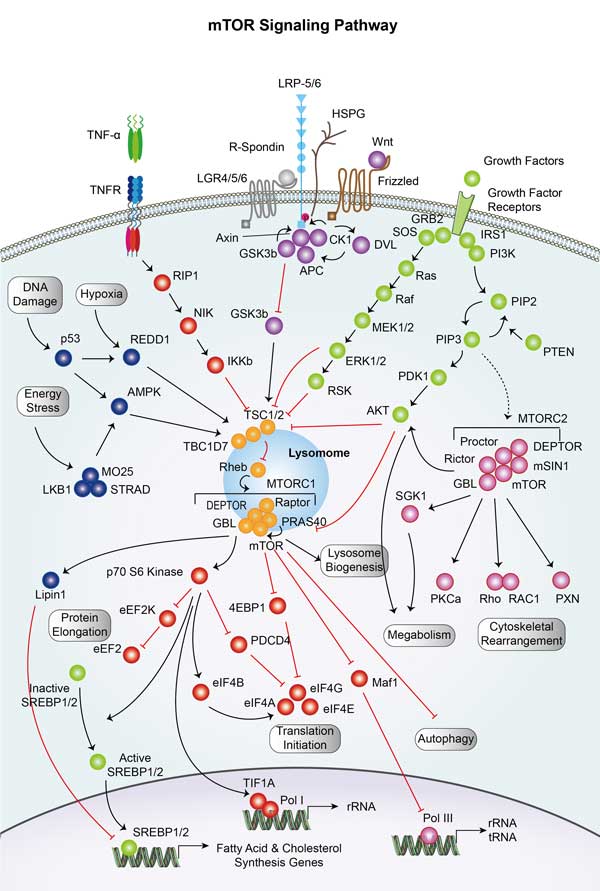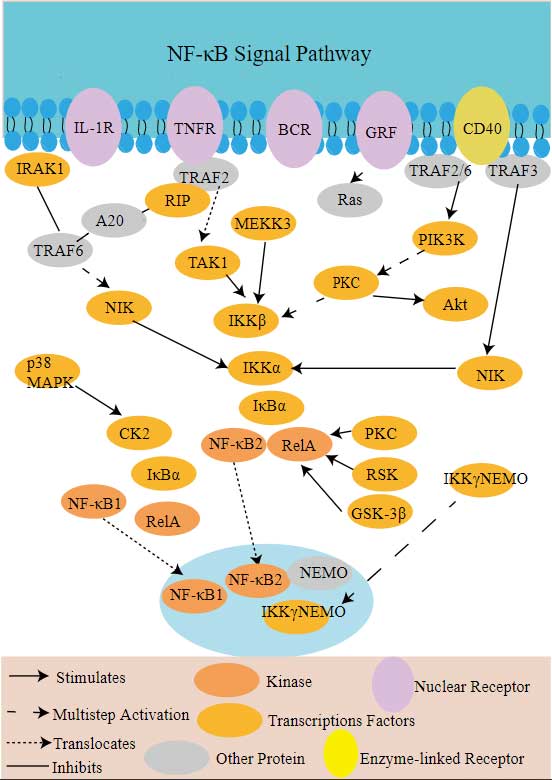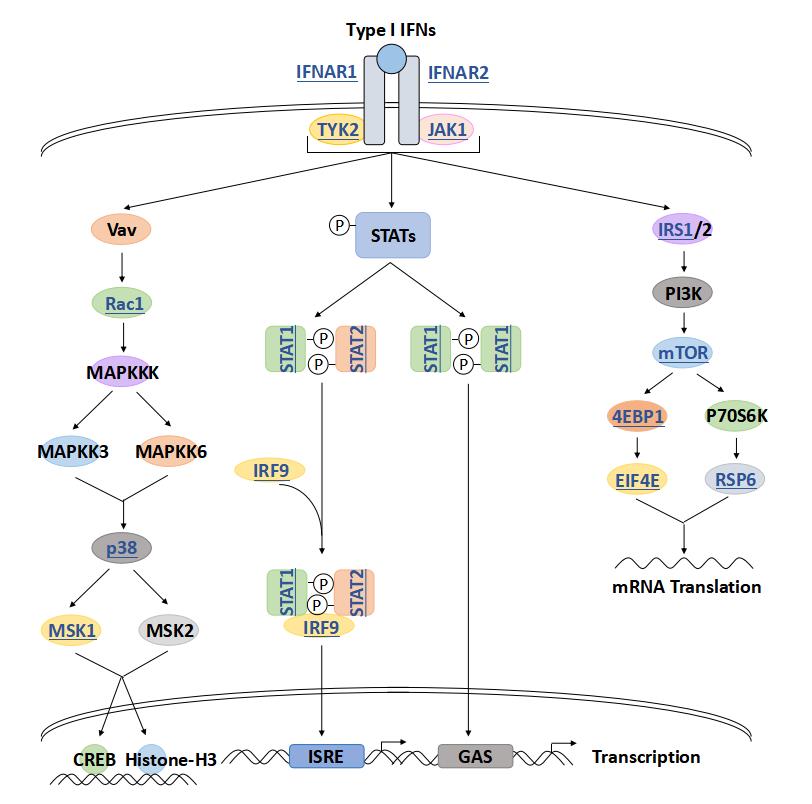PIK3CA
-
Official Full Name
phosphoinositide-3-kinase, catalytic, alpha polypeptide -
Overview
Phosphatidylinositol 3-kinase is composed of an 85 kDa regulatory subunit and a 110 kDa catalytic subunit. The protein encoded by this gene represents the catalytic subunit, which uses ATP to phosphorylate PtdIns, PtdIns4P and PtdIns(4,5)P2. This gene has been found to be oncogenic and has been implicated in cervical cancers. -
Synonyms
PIK3CA;phosphoinositide-3-kinase, catalytic, alpha polypeptide;phosphatidylinositol-4,5-bisphosphate 3-kinase catalytic subunit alpha isoform;PI3K;PI3K-alpha;PI3-kinase p110 subunit alpha;ptdIns-3-kinase subunit p110-alpha;serine/threonine protein
Recombinant Proteins
- Human
- Bovine
- Chicken
- Mouse
- Rhesus macaque
- Insect Cell
- Sf9 Insect Cell
- Insect (sf21)
- Mammalian Cell
- HEK293
- E.coli
- His
- GST
- Non
- Flag
- His&Fc&Avi
Involved Pathway
PIK3CA involved in several pathways and played different roles in them. We selected most pathways PIK3CA participated on our site, such as Inositol phosphate metabolism,ErbB signaling pathway,Ras signaling pathway, which may be useful for your reference. Also, other proteins which involved in the same pathway with PIK3CA were listed below. Creative BioMart supplied nearly all the proteins listed, you can search them on our site.
| Pathway Name | Pathway Related Protein |
|---|---|
| Insulin signaling pathway | GRB2B,INPP5K,PHKG1,AKT1,PRKACBA,CALML3,MAP2K2B,TRIP10A,PHKB,PRKAR1B |
| Non-alcoholic fatty liver disease (NAFLD) | UQCRFS1,PRKAG3,SDHC,NDUFA4L2,UQCRC1,NDUFS7,NDUFA11,IL6R,AKT2,NDUFS1 |
| Small cell lung cancer | PIK3R3,ITGB1,LAMB3,XIAP,LAMC2,RELA,PIK3CG,NFKBIA,RARB,TRAF6 |
| Influenza A | TMPRSS4,CASP1,IFNGR1,IL12B,PIK3R2,NFKB1,MAPK12,RNASEL,MYD88,IFNA7 |
| Glioma | CALM1,CAMK2A,MAP2K2,MAPK3,BRAF,PTEN,IGF1R,PRKCA,ARAF,PIK3R5 |
| Phosphatidylinositol signaling system | TMEM55B,MTMR6,PIK3R3A,MTM1,OCRL,PIK3CB,MTMR3,PIP5K1BA,INPP5K,INPP1 |
| Fc gamma R-mediated phagocytosis | PRKCA,RAF1,GSN,VAV2,PRKCB,PPAP2A,WASF2,PLA2G4F,BIN1,WASF3 |
| TNF signaling pathway | SOCS3,CCL5,MAP2K7,LIF,TNFRSF1A,CFLAR,LTA,Casp3,NFKB1,TAB2 |
| Toxoplasmosis | NFKBIA,ALOX5,HSPA6,IRAK1,SOCS1,HLA-DRB3,HSPA1A,PIK3R2,HLA-DQB1,BAD |
Protein Function
PIK3CA has several biochemical functions, for example, 1-phosphatidylinositol-3-kinase activity,1-phosphatidylinositol-4-phosphate 3-kinase activity,ATP binding. Some of the functions are cooperated with other proteins, some of the functions could acted by PIK3CA itself. We selected most functions PIK3CA had, and list some proteins which have the same functions with PIK3CA. You can find most of the proteins on our site.
| Function | Related Protein |
|---|---|
| 1-phosphatidylinositol-3-kinase activity | PIK3R3,ATM,PIK3C2G,PIK3C3,PIK3CB,PIK3C2A,PIK3C2B,PIK3CG,PIK3CD |
| 1-phosphatidylinositol-4-phosphate 3-kinase activity | PIK3CD,PIK3CB,PIK3CG,PIK3C2B,PIK3C2G,PIK3C2A |
| insulin receptor substrate binding | PRKCZ,INSRB,PTPN11,JAK2,INSR,INSRA,PRKCD,IGF1R,INSRR,IGF1RA |
| phosphatidylinositol 3-kinase activity | PIK3CB,PIK3CD,PIK3CG,PIK3C2A |
| ATP binding | TIE1,NIM1K,CASKA,NME2B.1,ABCC3,INSRR,CDK1,PSKH2,LRRK2,TRPM6 |
| protein serine/threonine kinase activity | MAP2K3,SRPK1,RIOK2,CDKL5,TSSK4,MAP2K4,CDC42BPB,PSKH2,MAP4K4,PRKCB |
| phosphatidylinositol-4,5-bisphosphate 3-kinase activity | PIK3CB,PIK3CG,PIK3CD |
| protein binding | LDB3,KCNH1,ADD1,XIAP,FRG1,FAM129A,ARR3,MMP15,DDO,HIPK4 |
| kinase activity | CCL3,PDXK,PFKFB2A,MASTL,GRK1A,PTK2BB,KITA,TSSK5,CKMT2B,GM4922 |
Interacting Protein
PIK3CA has direct interactions with proteins and molecules. Those interactions were detected by several methods such as yeast two hybrid, co-IP, pull-down and so on. We selected proteins and molecules interacted with PIK3CA here. Most of them are supplied by our site. Hope this information will be useful for your research of PIK3CA.
PIK3R1;IRS1
PIK3CA Related Signal Pathway
Resources
Related Services
Related Products
References
- Ciombor, KK; Wu, C; et al. Recent Therapeutic Advances in the Treatment of Colorectal Cancer. ANNUAL REVIEW OF MEDICINE, VOL 66 66:83-95(2015).
- Treilleux, I; Arnedos, M; et al. Translational studies within the TAMRAD randomized GINECO trial: evidence for mTORC1 activation marker as a predictive factor for everolimus efficacy in advanced breast cancer. ANNALS OF ONCOLOGY 26:120-125(2015).







